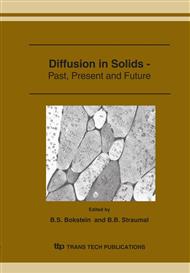p.61
p.73
p.81
p.91
p.97
p.105
p.111
p.115
p.119
Influence of Liquid-Glass Transition on Diffusion and Nucleation in Computer-Simulated Iron
Abstract:
A molecular dynamic model for instantaneously undercooled iron melt has been applied to model the isothermal annealing of the stable percolation clusters. They contain mutual penetrating and contacting icosahedra with atoms at the vertices and centers. Such stable clusters form only below the critical temperature Tg ~1180 K. We identify Tg as the glass transition temperature. It is established that the time when a homogeneous nucleation starts is minimal for Tg. The stable icosahedral percolation clusters do not form above Tg. The proposed quantitative model describes the atomic mobility in metal glasses, where root-mean-square atomic displacement is the sum of contributions from both linear (Einsteinian) and logarithmic terms, associated to irreversible structure relaxation. The activation parameters of the model change abruptly at the icosahedral percolation transition.
Info:
Periodical:
Pages:
97-104
Citation:
Online since:
January 2006
Keywords:
Price:
Сopyright:
© 2006 Trans Tech Publications Ltd. All Rights Reserved
Share:
Citation:


